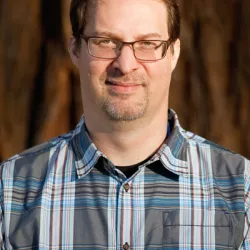HHRRC Testimonials
Hear from various individuals about how the Humanitarian and Human Rights Resource Center has impacted their work, their lives, and their mission to improve forensic science.

In 2020, I was honored to receive the Humanitarian and Human Rights Resource Center (HHRRC) Award from the American Academy of Forensic Sciences (AAFS), Colorado, U.S., with funding of $3,180.72 for my research project titled "Fingerprint Scan of the Dead: Real-Time Identification During the Search and Recovery Phase in Large-Scale Disasters." This research was made possible through funding provided to the HHRRC back then and it is crucial for the by the Forensic Science Foundation (FSF) to continue supporting such initiatives. This kind of support is vital for the advancement of humanitarian forensic science, enabling experts and researchers around the world to develop solutions that address critical needs. My research has contributed to raising awareness of the importance of proper identification and management of the deceased during disasters in Malaysia.
- Dr. Khoo Lay See
In 2015, the AAFS' Humanitarian and Human Rights Resource Center (HHRRC) funded the "Application of Stable Isotope Forensics to the Identification of Unidentified Border Crossers from the Texas-Mexico Border" to California State University, Chico. This research helped create large reference datasets of stable isotope values that can be used to predict probable regions of origin of unidentified deceased individuals, including undocumented border crosser deaths along the southern border of the United States. The research supported numerous graduate student positions, provided baseline data for future research projects, and resulted in several additional collaborative projects, including Saskia Ammer's HHRRC research "Reuniting the Remains of Undocumented Border Crossers with their Families through Isotope Analysis (US-Mexico Border)." The project provided novel stable isotope approaches for the identification of foreign nationals and undocumented migrants and served as a triage tool for cases with uncertain contexts. Funding from the HHRRC resulted in publications in the Journal of Forensic Sciences, Forensic Science International, Forensic Anthropology, and in edited volumes such as New Perspectives in Forensic Human Skeletal Identification, Humanitarian Forensic Science: Interacting with the Dead and the Living, Sociopolitics of Migrant Death and Repatriation: Perspectives from Forensic Science, and Methodological and Technological Advances in Death Investigations: Application and Case Studies. California State University, Chico, appreciats the support and continued collaboration with the HHRRC.
- Dr. Eric J. Bartelink, PhD
I have worked with multiple international partners as a collaborator on HHRRC-funded projects. Those projects have addressed specific humanitarian problems in Tanzania and Colombia, but the broader impacts extend beyond those countries and the collaborative agencies. They have supported women-led organizations and the doctoral work of a young woman as an emerging forensic science practitioner, as well as laid the groundwork for expansive forensic science training. HHRRC is about building a network and strengthening science globally. This is not an effort exclusive to these isolated projects- the science makes us ALL better forensic practitioners and holds our discipline to the highest standards in innovation. HHRRC projects are LEADING progress and advancing forensic science for everyone.
- Dr. Tiffany B. Fracchia, PhD
In 2024, the University of Dodoma (Tanzania), in partnership with Vanderbilt University (USA), was awarded funding by the Humanitarian and Human Rights Resource Center (HHRRC) of the American Academy of Forensic Sciences (AAFS) to support a capacity-building initiative for the Tanzania Police focused on the application of stable isotope analysis in the identification of the deceased. The rationale was to respond to the challenge of the migrants who chose the southern route from the Horn of Africa as an escape route to South Africa. This HHRRC support enabled the Tanzanian law enforcement and forensic practitioners to receive specialised training in the application of stable isotope analysis for identifying unknown deceased individuals, especially in cases involving undocumented persons, migrants, or mass disasters.
The project introduced innovative methodologies not implemented in the region, positioning Tanzanian institutions to address complex forensic cases with greater scientific rigour and cultural sensitivity. This project applied scientific expertise to one of the most pressing human rights challenges: restoring names to the nameless and dignity to the deceased.
In response to the increasing humanitarian challenges, the workshop recommended organizing a stakeholder forum to explore best practices for identifying deceased migrants and tracing their families. It also proposed the establishment of a regional centre in East Africa dedicated to stable isotope analysis and the identification of missing persons and migrants, the development of a regional isotopic baseline database to support forensic investigations, and the advancement of professional expertise in stable isotope techniques among forensic practitioners.
This project clearly illustrates how the HHRRC's research support fills a critical gap that no other funding body or institution consistently addresses. It demonstrates that the AAFS, through the HHRRC, is not only a hub of scientific excellence but also a catalyst for global justice, dignity, and forensic innovation. The outcomes of this work continue to resonate beyond national borders, affirming the HHRRC's role as a vital, mission-driven pillar of the Academy's international impact.
The outcomes of the 2024 HHRRC-funded initiative in Tanzania highlight the critical need for continued support of research that applies forensic science to ongoing humanitarian challenges worldwide. The funding not only enhanced the capacity of Tanzanian police through training in stable isotope analysis but also catalyzed regional momentum toward establishing long-term forensic infrastructure in East Africa. The recommendations, such as developing a stakeholder forum, creating an East African center for isotope analysis and missing persons identification, and building a regional isotopic baseline, demonstrate the far-reaching impact of HHRRC support. To continue promoting scientific innovation, ethical practice, and global collaboration, a continued research collaboration with HHRRC will ensure that forensic science remains a powerful tool for justice, dignity, and human rights worldwide.
The University of Dodoma appreciates the support and would wish continued collaboration with HHRRC.

The HHRRC grant was a turning point for forensic humanitarian work in the Republic of Georgia. It enabled our team (Georgian Association of Forensic Anthropology/GAFA) to conduct the first systematic recovery and analysis of human remains from Soviet-era repression, specifically from mass graves associated with Stalin's Great Terror in the Adjara region. This led to the first scientific identifications of victims executed without trial during the 1937–1938 purges, and the return of their remains to surviving family members. For these families, many of whom had endured decades of silence and uncertainty, the project brought long-awaited answers, truth, and the opportunity for dignified reburial. The grant also played a critical role in building Georgia's forensic capacity by introducing international standards, enabling interdisciplinary training, and empowering a new generation of local experts. Without HHRRC's support, this essential combination of scientific rigor, ethical family engagement, and national remembrance would not have been possible. This work has deeply shaped the direction of our national forensic anthropology efforts.
Here I am also sharing with you a link to a short documentary made by Al Jazeera, which highlights the human and scientific impact of the project: